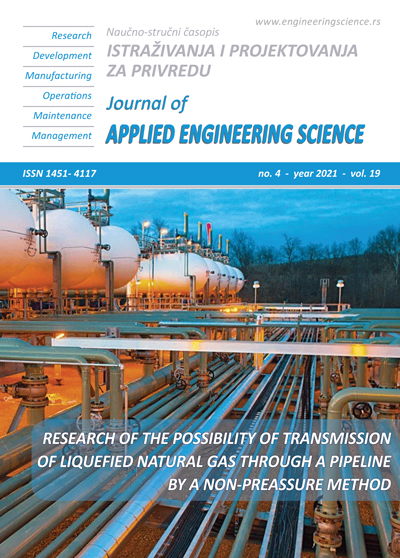EFFECT OF HUMID TROPICAL CLIMATE ON FRICTION CHARACTERISTIC OF PNEUMATIC CYLINDERS
Effect Of Humid Tropical Climate On Friction Characteristic Of Pneumatic Cylinders
Abstract
The pneumatic cylinder is influenced by many various factors at work, including the climate environment. The climatic environment consists of two characteristic factors as temperature (T) and relative humidity (RH), which change according to seasons and different geographical regions. Therefore, changing the climate characteristic factors will affect the friction characteristic of pneumatic cylinders when operating at different speeds. This article presents empirical research on the simultaneous effects of temperature and relative humidity of the environment with the humid tropical climate in Vietnam on the pneumatic cylinder's friction properties. According to experimental planning, the studies were conducted on industrial pneumatic cylinders with two input factors: the temperature of 150C, 320C and 490C and relative humidity of 51%, 75% and 99%, with velocities of 30, 50 and 100 mm/s. The results show that the static friction force and dynamic friction decrease when T, RH increases, and the influence of air relative humidity on friction force is more significant than temperature. The experiment also gives an empirical regression equation on the relationship of friction in the pneumatic cylinder, depending on the two factors of temperature and relative humidity of the humid tropical climate in Vietnam with velocities of 30, 50 and 100 mm/s.
References
[2] Nguyen Anh Tuan, Pham Van Hung, Viet nam tropical climate parameters influence the wear of cast iron, International symposium on high performance of tribosystem,Republic of korea, 26-27,2000, pp. 84-88
[3] Mohammad Asaduzzaman Chowdhurya,*and Maksud Helalib, The Effect of Frequency of Vibration and Humidity on the Coefficient of Friction, Tribology International, 39, pp. 958-962, 2006, doi:10.1016/j.triboint.2005.10.002.
[4] Imada Y, Effect of humidity and oxide products on the friction and wear properties of mild steel. J Jpn Soc Tribol, 114 (1996) pp.131–40.
[5] J. K. Lancaster, A review of the influence of environmental humidity and water on friction, lubrication and wear, Tribology Internation, (1990) pp.371-389, doi: 10.1016/0301-679X(90)90053-R.
[6] Mohammad Asaduzzaman Chowdhury*,1, and Maksud Helali2, The Effect of Relative Humidity and Roughness on the Friction Coefficient under Horizontal Vibration, The Open Mechanical Engineering Journal, 2(2008) pp.128-135, doi: 10.2174/1874155X00802010128
[7] Mohammad Asaduzzaman Chowdhury, Effect of Sliding Velocity and Relative Humidity on Friction Coefficient of Brass Sliding against Different Steel Counterfaces, International Journal of Engineering Research and Applications (IJERA), 2(2) (2012) pp. 1425-1431.
[8] Mohammad Asaduzzaman Chowdhury, Md. MaksudHelali, The effect of frequency of vibration and humidity on the wear rate, Wear 262(2007) pp.198–203, doi: 10.1016/j.wear.2006.05.007
[9] T. Raparelli, A. Manuello Bertettot and L. Mazzat, Experimental and numerical study of friction in an elastomeric seal for pneumatic cylinders, Tribology international, Vol. 30(1997). No. 7, pp. 547-552, doi: 10.1016/S0301-679X(97)00015-7
[10] B. M. Y. Nouri, Friction Identification in Mechatronic Systems, ISA Transactions, Vol. 43, 2004, pp. 205-216.
[11] Xuan Bo Tran, Hideki Yanada, Dynamic Friction Behaviors of Pneumatic Cylinders. Intelligent Control and Automation, 4(2013), 180-190, doi: 10.4236/ica.2013.42022
[12] Tran Xuan Bo1*, Do Viet Long1, and Hideki Yanada2, Dynamic friction behavior in pre-sliding regime of pneumatic actuators, ASEAN Engineering Journal, Vol 7 No 1(2017), pp. 50 -68.
[13] Yasunori WAKASAWA, Yuhi ITO and Hideki YANADA, Friction and Vibration Characteristics of Pneumatic Cylinder, The 3rd International Conference on Design Engineering and Science, ICDES 2014 Pilsen, Czech Republic, August 31 – September 3, 2014.
[14] Niko Herakovič, Jože Duhovnik, Dragica Noe, Friction Force in the Pneumatic Cylinder, Strojniški vestnik - Journal of Mechanical Engineering, 38,10-12, pp.279-288, 1992.
[15] Takahiro KOSAKI, Manabu SANO; Effect of Sliding Surface Temperature on Frictional Force in a Pneumatic Cylinder; transactions of the Japan hudraulics & Pneumatics society; Vol 32 Issue 4, pp.98-103, 2001, DOI: 10.14888/jfps1998.32.98
[16] Thuy-Duong Nguyen, Van – Hung Pham; Study of the effects of relative humidity and velocity on the friction characteristics of pneumatic cylinders; International Journal of Modern Physics B, Vol. 34, Nos. 22–24(2020), pp.20401391-5, DOI: 10.1142/S0217979220401396
[17] V.-H. Pham, T.-D. Nguyen,* T.-A. Bui; Behavior of Friction in Pneumatic Cylinders with Different Relative Humidity; Tribology in Industry, Vol 42, No 3(2020), pp.400-406, DOI: 10.24874/ti.878.04.20.07
[18] Thuy-Duong Nguyen, Van -Hung Pham; Influence of humid air temperature on friction behavior in pneumatic cylinder, Tribology in Industry, Vol 42, No 4. 2021; DOI: 10.24874/ti.976.10.20.01
[19] P.A. Lieberzeit, A. Rehman, B. Najafi, F.L. Dickert, Real-life application of a QCM-based e-nose: quantitative characterization of different plant-degradation processes, Anal. Bioanal. Chem. 391 (2008) 2897–2903.
[20] Nguyễn Minh Tuyển, Quy hoạch thực nghiệm, Nhà xuất bản khoa học kỹ thuật, (2004).
[21] I. v. Kragelsky, Friction Wear Lubrication.
Tribology Handbook. Pergamon Press, Vol 1, 1981.

